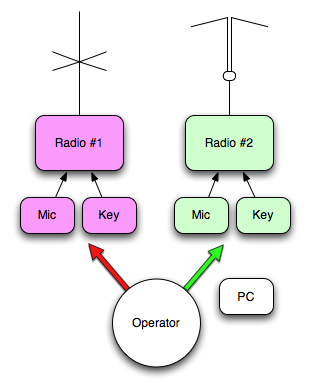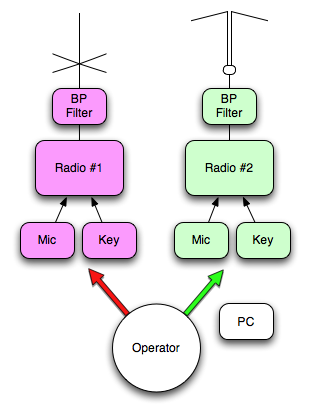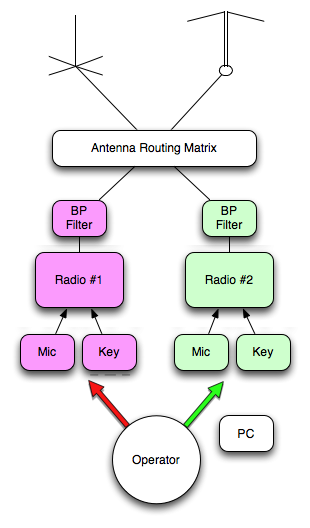In my many years as a ham, I somehow missed the whole topic of the Single Operator Two Radio (SO2R) technique for amateur radio contesting. I pulled up a few YouTube videos showcasing the great operators using this technique and convinced myself SO2R is interesting enough to research.
The ability to add a bit more excitement to those late contest constant CQs with an additional radio looking for other contacts, especially new multipliers, is inviting.
There are many resources on the Internet about why to do SO2R. I invite the reader to explore these resources. We will review a couple key concepts on why to do SO2R and then dig in deep to some technical approaches.
Reasons for SO2R
- Use an extra radio to search and pounce extra contacts while calling CQ with the “main” radio
- Turn late contest dead time into productive search and pounce on another band while still maintaining CQ on another channel
- Operated two bands at once – only one carrier at a time of course
- Multipliers can be significantly enhanced for your score
- Make better use of your antenna farm resources – two in use at a time rather than just one – again only one transmitting at a time
Basic SO2R
In theory SO2R can be accomplished with minimal resources. The figure below reveals just such a configuration…

Key points include:
- Two transceivers each with mic and keys
- Two antennas suitably arranged to minimize mutual coupling – in this example Radio #1 uses a vertical antenna while Radio #2 uses a horizontal
- One computer to record contacts (yes, I know… I know this is not a practical contesting setup, but is possible)
- One savvy operator who can manage two radios at once and move between the two
Two Transceivers
Having two sets of inputs (mic and key) for the radios is not an ideal SO2R approach, but will work. One advantage of this arrangement is you always know exactly which radio you are transmitting with unlike more complicated approaches discussed in future posts.
Antennas
Since you are contesting, you are probably working on most or all of the usual 160, 80, 40, 20, 15 and 10 contesting bands. If you have only two antennas, each will need to be some kind of multi-band type. Another approach is to have one antenna on the lower bands and the other on the high bands. A tuned feed all bander for the low and a 20-15-10 beam for the high bands is one possibility.
Dual Microphone and Morse Paddles
While ultra redundant, having two mics and two Morse code keys is a mixed blessing. You probably have a favorite key which cost you good coin; Duplicating that can be expensive.
Logging Computer
No contest is really possible without the advantage of computerized contact logging. Dupe checking is the obvious benefit. Most folks connect their logging computers to their radio’s CAT port. However, if your logging software can’t handle multiple rigs you may as well leave it disconnected so your band settings can be set to whatever band “either” radio is on.
Summary of Barebones SO2R
Can Barebones SO2R work? If you have an extra rig and two antennas suitably arranged, sure. However, there has to be a better way. Read the next post for the next step up in SO2R complexity.


Does anyone else find this mode of operating annoying? How much time is lost by OTHER operators answering a CQ when the SO2R person is either looking for multipliers or just not at the rig at all. I assume courtesy to others in contests is now
officially dead.
73 Tony G3ZRJ